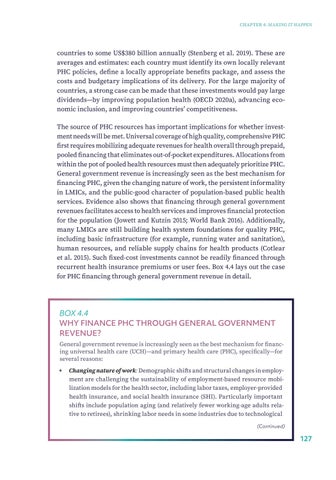CHAPTER 4: MAKING IT HAPPEN
countries to some US$380 billion annually (Stenberg et al. 2019). These are averages and estimates: each country must identify its own locally relevant PHC policies, define a locally appropriate benefits package, and assess the costs and budgetary implications of its delivery. For the large majority of countries, a strong case can be made that these investments would pay large dividends—by improving population health (OECD 2020a), advancing economic inclusion, and improving countries’ competitiveness. The source of PHC resources has important implications for whether investment needs will be met. Universal coverage of high quality, comprehensive PHC first requires mobilizing adequate revenues for health overall through prepaid, pooled financing that eliminates out-of-pocket expenditures. Allocations from within the pot of pooled health resources must then adequately prioritize PHC. General government revenue is increasingly seen as the best mechanism for financing PHC, given the changing nature of work, the persistent informality in LMICs, and the public-good character of population-based public health services. Evidence also shows that financing through general government revenues facilitates access to health services and improves financial protection for the population (Jowett and Kutzin 2015; World Bank 2016). Additionally, many LMICs are still building health system foundations for quality PHC, including basic infrastructure (for example, running water and sanitation), human resources, and reliable supply chains for health products (Cotlear et al. 2015). Such fixed-cost investments cannot be readily financed through recurrent health insurance premiums or user fees. Box 4.4 lays out the case for PHC financing through general government revenue in detail.
BOX 4.4 WHY FINANCE PHC THROUGH GENERAL GOVERNMENT REVENUE? General government revenue is increasingly seen as the best mechanism for financing universal health care (UCH)—and primary health care (PHC), specifically—for several reasons: ++ Changing nature of work: Demographic shifts and structural changes in employment are challenging the sustainability of employment-based resource mobilization models for the health sector, including labor taxes, employer-provided health insurance, and social health insurance (SHI). Particularly important shifts include population aging (and relatively fewer working-age adults relative to retirees), shrinking labor needs in some industries due to technological (Continued)
127


